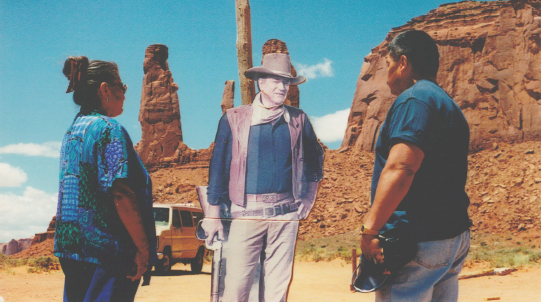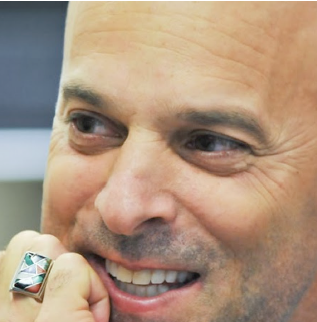
RIO DE JANEIRO/QUEBEC CITY, May, 10, 2015 - The 5th International Uranium Film Festival screened more than 40 documentaries, short films, animations and fiction movies about nuclear power, uranium risks and atomic bombs in Quebec. The Grand Council of the Crees (Eeyou Istchee) was the event's principal host of this in the world most important film festival about nuclear energy and radioactive risks in Quebec. The annual Uranium Film Festival - that had its first edition in Rio de Janeiro in 2011- awards every year the best and most important films with its Yellow Oscar and the special achievement awards. In addition a special Yellow Oscar will be given now to the film "The Return of Navajo Boy" and its director Jeff Spitz: The SOCIAL CONSCIENCE YELLOW OSCAR 2015.
“The 2000 produced moving documentary The Return of Navajo Boy, with its Epilogue and webisodes, demonstrates how a skilful film made with a social conscience - and a social impact campaign - can change the world", says the Uranium Film Festival Jury.
About the award winning film:
The Return of Navajo Boy
USA 2000/2008, 57 min and 15 min, Epilogue / Documentary, Director:
Jeff Spitz, Produced by Jeff Spitz and Bennie Klain, www.navajoboy.com
The film chronicles an extraordinary chain of events, beginning with the appearance of a 1950s film reel, which lead to the return of a long lost brother to his Navajo family. Living for more than six decades in Monument Valley (on the Arizona/Utah border), the Cly family (rhymes with “sky”) has an extraordinary history in pictures. Since the1930's, family members have appeared as unidentified subjects in countless photographs and films shot in Monument Valley including various postcards, Hollywood Westerns and a rare home-movie by legendary director John Ford. But it is the sudden appearance of a rarely seen vintage film that affects their lives the most. With the return of “Navajo Boy,” Elsie Mae Cly Begay seizes the opportunity to tell her family’s story for the first time, offering a unique perspective to the history of the American west. Using a variety of still photos and moving images from the 40s and 50s and telling their family
story in their own voices, the Clys shed light on the Native side of picture making and uranium mining in Monument Valley.
The Return of Navajo Boy, an official selection of the Sundance Film Festival and PBS, is an internationally acclaimed documentary that reunited a Navajo family and triggered a federal investigation into uranium contamination. It tells the story of Elsie Mae Begay, whose history in pictures reveals an incredible and ongoing struggle for environmental justice. A powerful new epilogue (produced in 2008) shows how the film and Groundswell Educational Films’ outreach campaign create news and rally supporters including Congressman Henry Waxman (D-CA). The Chairman of the Committee on Oversight and Government Reform mandated a clean-up plan by the five agencies that are responsible for uranium contamination (Environmental Protection Agency, Department of Energy, Nuclear Regulatory Commission, Indian Health Service and Bureau of Indian Affairs).
The documentary, epilogue and now 15 webisodes have leveraged several remarkable impacts: Bernie Cly, one of the Navajo family featured, has been awarded $100,000 in compensation from the US government; the EPA demolished a dangerous house made out of uranium which was featured in the film and completed its $8 million dollar clean up of the abandoned uranium mine located in the backyard of the Navajo family featured in the documentary. The most recent webisode in April 2014, informs viewers that the Navajo tribe won the largest environmental settlement in American history, $1 billion payout from Kerr-McGee, the corporate contaminator exposed by the documentary. (Photo: Jeff Spitz) Film website: www.navajoboy.com
About the Yellow Oscar
 The Yellow Oscar is a piece of art produced by Brazilian waste material artist Getúlio Damado, who lives and works in the famous artist quarter Santa Teresa in Rio de Janeiro where the first International Uranium Film Festival was held in May 2011. Getúlio creates the "Yellow Oscar" from waste material, that he finds in the streets of Santa Teresa. He uses also old watches to remember the first atomic bomb dropped over Hiroshima. Watches in Hiroshima stopped exactly at 8:15 in the morning when the A-bomb exploded on August 6th, 1945.
The Yellow Oscar is a piece of art produced by Brazilian waste material artist Getúlio Damado, who lives and works in the famous artist quarter Santa Teresa in Rio de Janeiro where the first International Uranium Film Festival was held in May 2011. Getúlio creates the "Yellow Oscar" from waste material, that he finds in the streets of Santa Teresa. He uses also old watches to remember the first atomic bomb dropped over Hiroshima. Watches in Hiroshima stopped exactly at 8:15 in the morning when the A-bomb exploded on August 6th, 1945.
The 5 Yellow Oscars 2015. The Yellow Oscar is a piece of art produced by Brazilian waste material artist Getúlio Damado, who lives and works in the famous artist quarter Santa Teresa in Rio de Janeiro where the first International Uranium Film Festival was held in May 2011.
Support the Uranium Film Festival! Make a donation.
Contact: info@uraniumfilmfestival.org




